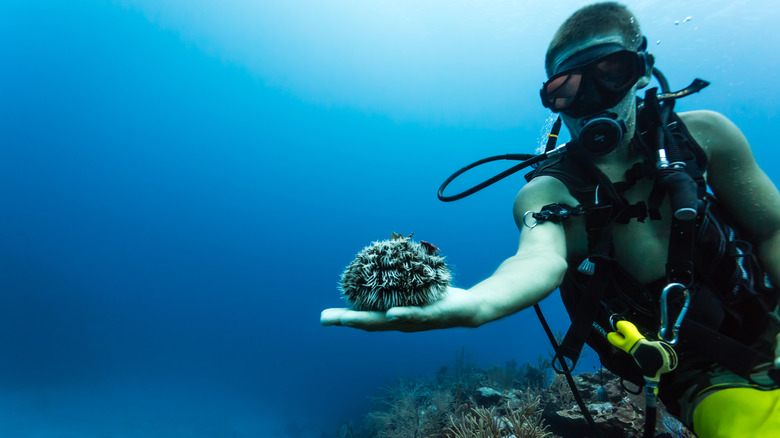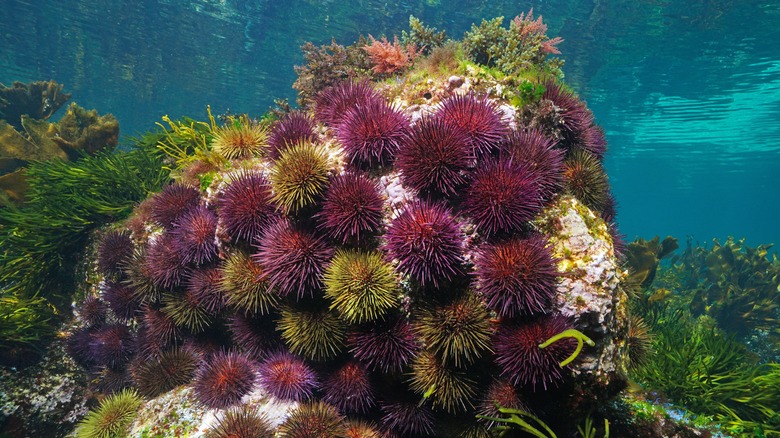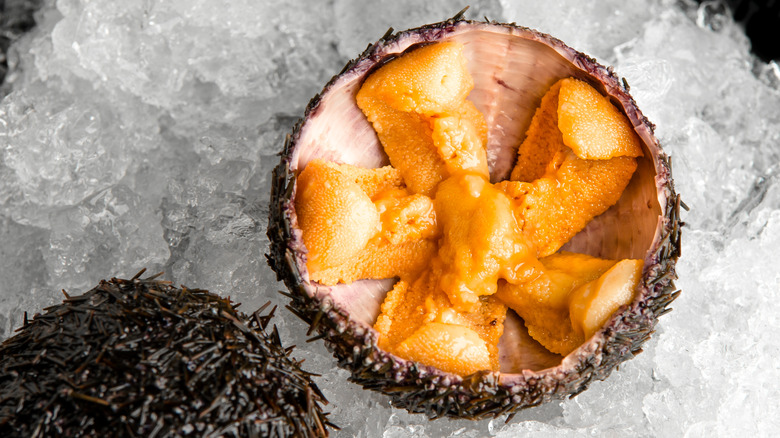How To Dive For Sea Urchins And The Best Way To Eat Them
If you've ever eaten sea urchin, aka uni on sushi menus, or even mixed with butter for a luscious topper on pasta, you may describe the buttery, briny flavor as incomparable. However, uni can be expensive and sometimes hard to find. The solution: Dive and find your own if you're in the right location.
While sea urchins can be found in various places around the globe, if you're looking to forage for them in US waters, your best bets are off the coast of Maine or along the West Coast. If you're on the West Coast, you're in a great spot to find sea urchins any time of the year, while divers in the Atlantic Ocean off of the Northeast Coast will want to suit up in the winter.
To prepare for a dive, make sure that you have all the necessities for success. You'll need a wetsuit, of course, as well as snorkel gear like a mask and fins (or scuba equipment if that's your diving choice). Wearing the appropriate gloves will help to keep your hands warm as well as protect them from the sea urchins' spines. Be sure to bring along your weight belt, as well.
You'll also want to carry a tool with you to remove the sea urchins from where they are attached. A pick or a sharp knife will help make that task easier. Finally, be sure to take something with you to store the sea urchins like a mesh bag.
What to look for when diving for sea urchins
While there are nearly 1,000 types of sea urchin, less than 20 of them are edible, so it's important to know what to look for when you are foraging. If you're diving in the Pacific Ocean, look for urchins that are red, while in the Atlantic, you can find ones that are purple. You can also keep your eyes out for green sea urchins, which habitate in both bodies of water. All of these urchins will be round in shape as well as spiny.
Sea urchins can be found in waters of various depths, from shallow tidewaters to deep in the sea. You'll often find them on rocks, which they attach to using their feet. Since sea urchins feed on kelp and barnacles (among other things like plankton), you can look for those too to help guide you toward a spot where you may find the sea creatures in abundance.
Once you've found the urchins, you can carefully remove them from the rock and place them in your bag. While you can eat the urchins raw and straight from the shell, if you're choosing to save them to cook later, be sure to store them in an airtight container in the refrigerator while they're still alive. They will remain safe to eat for up to two days.
Removing sea urchins from their shells and cooking them
The first part of preparing sea urchin to eat is to remove the edible portion (the gonads) from the shell. Start by filling a large bowl with fresh, cold water. Then, use kitchen shears to gently slice into the shell around the urchin's mouth before removing that portion and flipping the urchin over to pour out any moisture still inside. Using a spoon, gently remove the gonads, dipping in water if necessary to keep them from breaking apart. You may also need to use tweezers, or a similar tool, to delicately remove any attached organs.
Fresh, raw uni will last up to two days in the refrigerator, and you can use it on homemade sushi or spread it on crostini or crackers. If you prefer to use it in a cooked dish, uni is a great thickener that can impart rich, umami flavor to soups, stews, and sauces. Consider making an uni-upgraded hollandaise sauce for your next brunch, or elevate your lasagna with an uni-infused bechamel sauce.
You can use uni to make an incredible compound butter worthy of spreading on a fresh baguette, tossing with pasta, or allowing to melt over a just-seared steak. And if you want to get adventurous, try making a savory ice cream with miso and uni or mix the urchins into a savory cocktail.
However you use uni, it is best to do it within its refrigerated shelf-life. Avoid freezing it so that it maintains its original flavor and unique texture.



